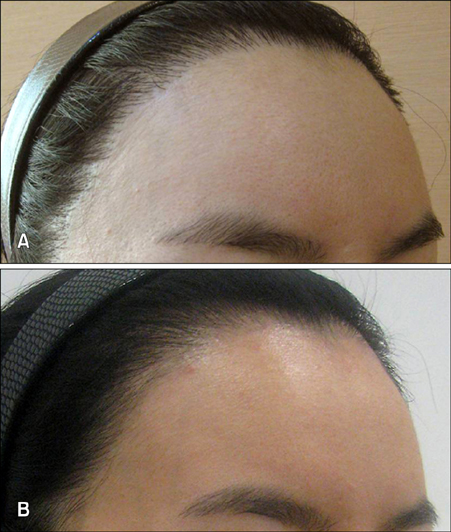Ann Dermatol.
2015 Feb;27(1):21-25. 10.5021/ad.2015.27.1.21.
Alternative Method for Creating Fine Hairs with Hair Removal Laser in Hair Transplantation for Hairline Correction
- Affiliations
-
- 1Department of Dermatology, Seoul National University Boramae Hospital, Seoul, Korea.
- 2Department of Dermatology, Hanhui Clinic, Seoul, Korea.
- 3Department of Dermatology, Modelo Clinic, Seoul, Korea. doctorseo@hotmail.com
- KMID: 2264832
- DOI: http://doi.org/10.5021/ad.2015.27.1.21
Abstract
- BACKGROUND
Foremost fine hairs in the frontal hairline region are critical in hair transplantation for hairline correction (HTHC) in women. However, there are few studies on a nonsurgical revisionary method for improving an unnatural foremost hairline with thick donor hairs resulting from a previous HTHC.
OBJECTIVE
To investigate the efficacy and safety of using a hair removal laser (HRL) system to create fine hairs in Asian women with thick donor hairs.
METHODS
Through a retrospective chart review, the HRL parameters, hair diameter (measured with a micrometer before and after the procedures), subjective results after the procedures, adverse effects, and the number of procedures were investigated. The reduction rate of the hair diameter was calculated.
RESULTS
Twenty-four women who received long-pulse Neodymium-Doped:Yttrium Aluminum Garnet therapy after HTHC were included. The parameters were as follows: delivered laser energy, 35~36 J/cm2; pulse duration, 6 ms; and spot size, 10 mm. The mean number of laser sessions was 2.6. The mean hair diameter significantly decreased from 80.0+/-11.5 microm to 58.4+/-13.2 microm (p=0.00). The mean rate of hair diameter reduction was -25.7% (range, -44.6% to 5.7%). The number of laser sessions and the hair diameter after the procedures showed a negative correlation (r=-0.410, p=0.046). Most of the patients (87.5%) reported subjective improvement of their hairlines. Most complications were transient and mild.
CONCLUSION
HRL can be an alternative method for creating fine hairs and revising foremost hairline in Asian women with thick donor hairs.
Keyword
MeSH Terms
Figure
Reference
-
1. Zviak C, Bouillon C. Hair treatment and hair care products. In : Zviak C, editor. The science of hair care. New York: Marcel Dekker Inc.;1986. p. 142.2. Swinehart JM. "Cloned" hairlines: the use of bisected hair follicles to create finer hairlines. Dermatol Surg. 2001; 27:868–872.
Article3. Unger WP. Hair transplantation in Orientals. In : Unger WP, editor. Hair transplantation. 3rd ed. New York: Marcel Dekker Inc.;1995. p. 285–286.4. Jones R. Body hair transplant into wide donor scar. Dermatol Surg. 2008; 34:857.5. Umar S. The transplanted hairline: leg room for improvement. Arch Dermatol. 2012; 148:239–242.6. Jung JH, Rah DK, Yun IS. Classification of the female hairline and refined hairline correction techniques for Asian women. Dermatol Surg. 2011; 37:495–500.
Article7. Holcomb JD, McCollough EG. Trichophytic incisional approaches to upper facial rejuvenation. Arch Facial Plast Surg. 2001; 3:48–53.
Article8. Ramirez AL, Ende KH, Kabaker SS. Correction of the high female hairline. Arch Facial Plast Surg. 2009; 11:84–90.
Article9. Marten TJ. Hairline lowering during foreheadplasty. Plast Reconstr Surg. 1999; 103:224–236.
Article10. Kang H, Kang TW, Lee SD, Park YM, Kim HO, Kim SY. The changing patterns of hair density and thickness in South Korean women with hair loss: clinical office-based phototrichogram analysis. Int J Dermatol. 2009; 48:14–21.
Article11. Rassman WR, Bernstein RM, McClellan R, Jones R, Worton E, Uyttendaele H. Follicular unit extraction: minimally invasive surgery for hair transplantation. Dermatol Surg. 2002; 28:720–728.
Article12. Kim JC, Choi YC. Regrowth of grafted human scalp hair after removal of the bulb. Dermatol Surg. 1995; 21:312–313.
Article13. Altshuler GB, Anderson RR, Manstein D, Zenzie HH, Smirnov MZ. Extended theory of selective photothermolysis. Lasers Surg Med. 2001; 29:416–432.
Article
- Full Text Links
- Actions
-
Cited
- CITED
-
- Close
- Share
- Similar articles
-
- Secondary Female Hairline Correction Surgery in Korean: Various Operative Techniques and Methods
- Photo Epilation with Intense Pulsed Light for Thinning of Anterior Hairline after Hairline Correction Surgery in East Asians
- Beard hair transplant to the hairline
- Hair Diameter Variation in Different Vertical Regions of the Occipital Safe Donor Area
- Asian Female Hairline Surgery Using Follicular Unit Extraction



